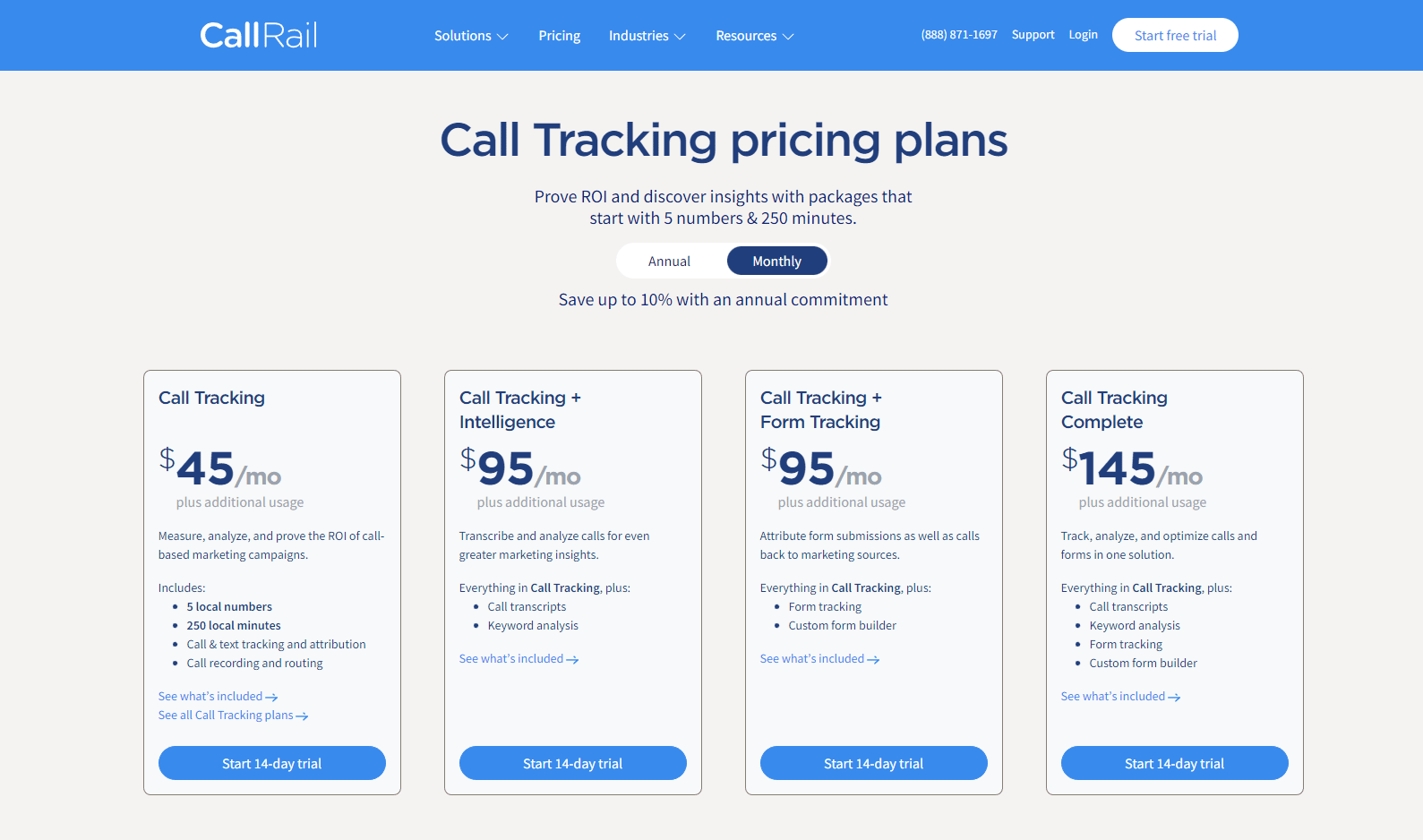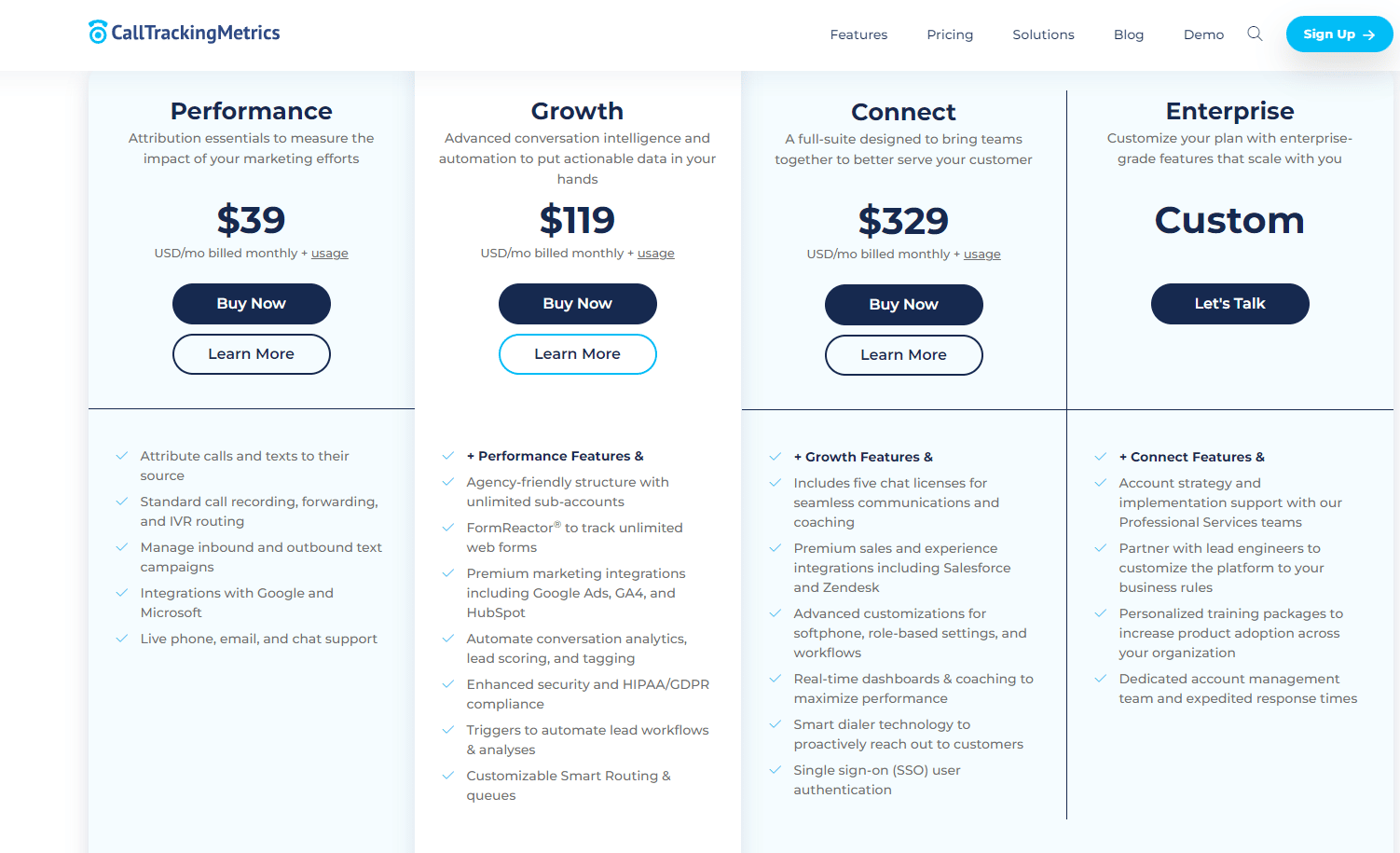Pay-per-click (PPC) campaigns live and die by their conversion data. Call tracking allows marketers to get valuable insights on all their campaigns.
However, there can be some hesitations to use it.
- Brands are afraid of missing out on brand equity with an established number.
- The cost on top of any other marketing cost seems high.
Understanding what call tracking is and how it can help will mitigate these concerns.
What is call tracking?
Call tracking involves using a unique phone number to track the source of incoming calls to a business. When a customer calls the business using a call-tracked phone number, the phone call is routed through a call tracking system which records details, such as:
- The caller’s phone number.
- Date and time of the call.
- Duration of the call.
- Wait time.
- Unique vs. repeat caller.
This information is used to track the effectiveness of marketing campaigns, determine trends in customer behavior, and identify opportunities to improve the sales process.
Call tracking allows the call to be attributed to a specific campaign. This is done either through static or dynamic numbers. Both forms will forward to a designated number (typically the main number for a business).
Static numbers do not change based on the site source and are assigned a channel. These numbers typically have a cost per number on top of a per minute charge.
Dynamic numbers change based on the site source and require you to pay for a number pool. The number pool will be based on traffic volume. If you try to go for too few numbers in your pool, you risk having attribution issues due to too few numbers being assigned to you.
Call tracking can include a recording or not. Depending on your industry, you may not be able to use the recording element of call tracking.
Call tracking recordings can offer transcripts for an additional fee.
How does call tracking work?
Call tracking can be implemented in various ways to fit all operational needs.
One common method is to use a call tracking service, which provides businesses with unique phone numbers that can be used to track the source of incoming calls. These numbers can be placed on:
- Websites.
- Social channels.
- Digital ads.
- Other marketing collateral.
When a customer calls one of these numbers, the call tracking service records information about the call and provides it to the business.
Another method of call tracking is to use a piece of software or hardware installed on the business’s phone system.
Software or hardware receives incoming calls and records information about the call before routing it to the appropriate extension or phone number.
This method of call tracking allows businesses to track calls made to their existing phone numbers, rather than requiring the use of unique tracking numbers.
Regardless of which method you choose, it’s important to designate whether you will use local or toll-free numbers.
Some brands are averse to toll-free numbers because they are concerned it hurts their branding or connection with the local community.
The verdict is out on whether those concerns hold water, so it’s important for brands to test both to confirm which serves them best.
Setting up call tracking
Setting up call tracking requires you to know which channels you want to track and what budget you have to work with.
You will need to add the snippet of code into your Google Tag Manager or running element on your site. The snippet is designed to look for one main number, so if you have multiple numbers on your site, you may need to:
- Opt for call tracking that connects to calls being made directly to your number.
- Know that only the number designated will change based on source when reviewing data.
Once you do, your UTM parameter will communicate with the snippet of code on the site to change the number to a number associated with the source.
If you decide to go with a call tracking vendor, you’ll need to layout the structure of which sources and “root” numbers you want to track.
As a general rule, the following are the most common sources to track:
- Direct traffic: Users who come directly to your site
- Organic: Users who search for something related to what you do and land on your site.
- PPC: Users who click ads and arrive on your site.
- Google Business Profiles: User calls the number from the Google Business Profile.
- Call extensions: User calls the phone number attached to the Google or Microsoft search ad.
- Social channels (should be segmented): User calls number on a social ad.
- Local service ads: User calls a local service ad (the number needs to be set up).
Brands can choose to segment as much or as little as they like.
Choosing to segment down to the campaign level will ensure you know exactly what’s working for you, however it will mean you need to pay for more numbers.
Lumping campaigns together may save on call tracking costs, but the 1:1 tracking will be lost and you’ll need to invest human time to properly attribute success.
Choosing a call tracking vendor
Disclaimer: No call tracking vendors paid for endorsement or placement in this article. Those listed are the ones the author has familiarity with and has seen applied. There is no right call tracking solution for everyone and all hold potential for a positive engagement. Additionally, this article is focused on U.S. call tracking.
Engaging a call tracking vendor is much like choosing a cell phone provider. The core service is the same, it's a question of how much support and reliability you can expect at various price points.
Call tracking integrations range from simple turnkey set-ups to custom and complex. Based on the structure you'll need and how you want to handle display numbers, these are the core criteria to think about:
- How does the call tracking vendor price minutes?
- What costs, if any, are there for specific numbers?
- Will the call tracking vendor offer transcripts and recordings? How much of an upcharge are they?
- Can I achieve full coverage of the initiatives I want to track within budget?
- What kind of technical support is available for me if I need it?
- What if any international coverage is there and at what cost?
Here are some of the most common call tracking solutions and how to think about them.
Marchex
Marchex focuses on dynamic numbers and requires an accurate website traffic calculation to provide enough numbers. Due to being phone pool heavy, they depend on the brand purchasing enough numbers and minutes to cover the click and call volume.
If a brand goes low on the website traffic, they risk having their numbers being used for other brands and paying for wrong numbers. If they overestimate it, then they will have wasted spend.
As a general rule, it's useful to think about traffic in 1,000 click increments.
Marchex has been called "easy" and "difficult" to use. Those who find value in Marchex will likely want simple and straightforward call tracking (unless they are willing to pay for the enterprise versions). Those trying to do more complex tasks or export reports/recordings will find the process a bit cumbersome.
Customer support for Marchex is hit or miss depending on what level of support you qualify for.
Marchex essential is $500 per month and requires a demo to get access pricing for their more robust offerings.
CallRail
CallRail is one of the most popular call tracking solutions. It offers fairly robust tracking and documentation, as well as many integrations to third party tools.
CallRail has fairly straight forward pricing that makes it easy to grow with. They follow more of the "Spirit Airline" school of thought on what's included vs. what are add-ons.
While default pricing puts them on the cheaper side, the add-ons that make them truly special push the final price to the middle of the road.

The main selling points for CallRail are:
- Option for local and toll-free numbers.
- Lead gen forms.
- Text messages (SMS).
- Transcriptions.
- Call quality scoring.
- Keyword level attribution.
- Thematic conversation reporting.
They lean very heavily into their support hub so if having a person to troubleshoot things with is important, you might be disappointed. That said they do offer chat and phone support from 9 a.m. to 9 p.m. ET.
CallTrackingMetrics
This is the call tracking solution I tend to use when given the option because of how flexible it can be and how much is included by default.
I appreciate their focus on customer support and ensuring their offering keeps up with tech innovations in the digital marketing industry.
Their pricing is accessible and for the most part all inclusive.

CallTrackingMetrics main selling points are:
- Local and toll-free numbers (along with the ability to port numbers).
- CRM functionality.
- In-depth call analytics (in premium plans).
- Call scoring and routing based on brand dictated weights.
- Text and form options (SMS).
- Privacy compliance.
One of the biggest selling points for CallTrackingMetrics is their support. It's top-notch and enables anything from set up to complex data analysis. They have a premier consulting offering for ala carte projects and provide premium support for their agency partners.
How does using call tracking help brands succeed online?
One of the biggest wins call tracking can do for a brand is illuminate the ROI on initiatives that might otherwise get missed.
From distilling the value on SEO content plays, to affirming which paid campaigns are truly delivering ROAS (return on ad spend), call tracking is essential to paint the clearest picture.
Another useful benefit of call tracking is auditing customer success and sales teams. By being able to go back and listen to the recordings of calls, teams can improve their interactions with prospects/customers, as well as get valuable insight into what delights and what causes churn.
Finally, call tracking solutions often come with additional features that can help brands consolidate services (like CRMs, SMS marketing, and lead gen forms). By going with a solution that covers multiple functions, you'll streamline your business and reduce costs.
The post Call tracking: What it is and how it works appeared first on Search Engine Land.
No comments:
Post a Comment